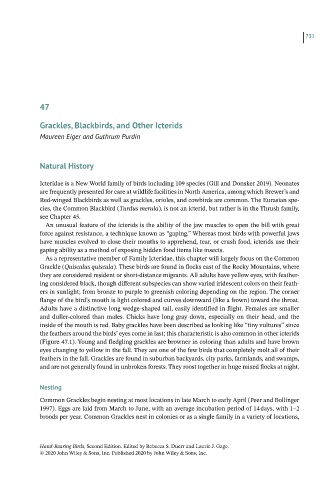Page 729 - Hand rearing birds second
P. 729
731
47
Grackles, Blackbirds, and Other Icterids
Maureen Eiger and Guthrum Purdin
Natural History
Icteridae is a New World family of birds including 109 species (Gill and Donsker 2019). Neonates
are frequently presented for care at wildlife facilities in North America, among which Brewer’s and
Red‐winged Blackbirds as well as grackles, orioles, and cowbirds are common. The Eurasian spe-
cies, the Common Blackbird (Turdus merula), is not an icterid, but rather is in the Thrush family,
see Chapter 45.
An unusual feature of the icterids is the ability of the jaw muscles to open the bill with great
force against resistance, a technique known as “gaping.” Whereas most birds with powerful jaws
have muscles evolved to close their mouths to apprehend, tear, or crush food, icterids use their
gaping ability as a method of exposing hidden food items like insects.
As a representative member of Family Icteridae, this chapter will largely focus on the Common
Grackle (Quiscalus quiscula). These birds are found in flocks east of the Rocky Mountains, where
they are considered resident or short‐distance migrants. All adults have yellow eyes, with feather-
ing considered black, though different subspecies can show varied iridescent colors on their feath-
ers in sunlight; from bronze to purple to greenish coloring depending on the region. The corner
flange of the bird’s mouth is light colored and curves downward (like a frown) toward the throat.
Adults have a distinctive long wedge‐shaped tail, easily identified in flight. Females are smaller
and duller‐colored than males. Chicks have long gray down, especially on their head, and the
inside of the mouth is red. Baby grackles have been described as looking like “tiny vultures” since
the feathers around the birds’ eyes come in last; this characteristic is also common in other icterids
(Figure 47.1). Young and fledgling grackles are browner in coloring than adults and have brown
eyes changing to yellow in the fall. They are one of the few birds that completely molt all of their
feathers in the fall. Grackles are found in suburban backyards, city parks, farmlands, and swamps,
and are not generally found in unbroken forests. They roost together in huge mixed flocks at night.
Nesting
Common Grackles begin nesting at most locations in late March to early April (Peer and Bollinger
1997). Eggs are laid from March to June, with an average incubation period of 14 days, with 1–2
broods per year. Common Grackles nest in colonies or as a single family in a variety of locations,
Hand-Rearing Birds, Second Edition. Edited by Rebecca S. Duerr and Laurie J. Gage.
© 2020 John Wiley & Sons, Inc. Published 2020 by John Wiley & Sons, Inc.

